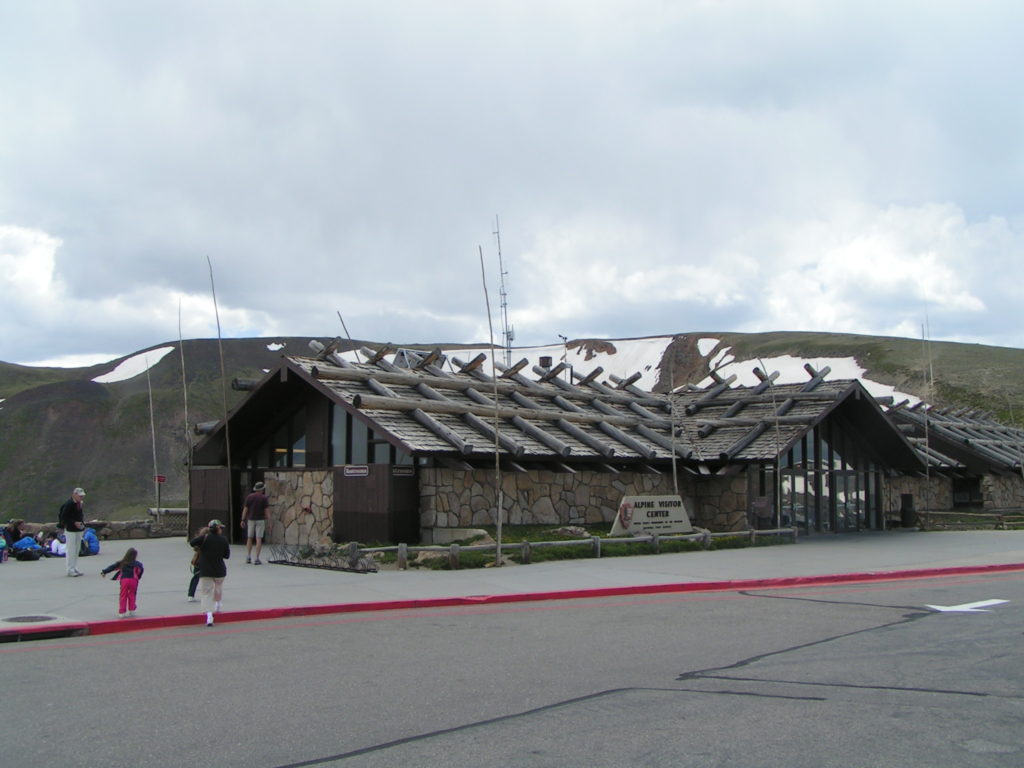
Alpine Visitor Center, Rocky Mountain National Park
It’s an impressive building, no doubt. Built sturdily with large pieces of rock anchoring its walls and a cross hatch of hewn logs, massive logs, anchoring its thatched roof. But it would have to be, given the harshness of its climate 365 days a year. The Alpine Visitor Center of Rocky Mountain National Park is the highest altitude visitor center in the entire national park system. At 11.796 feet above sea level surrounded by tundra, it must withstand strong winds and copious amounts of snow among other things. It is one of the finest achievements of the National Park Service’s Mission 66.
Mission 66 was a ten-year National Park Service initiative to put money into the national parks all over the country, to improve infrastructure and visitor services in preparation of the fiftieth anniversary of the National Park Service in 1966. Director Conrad Wirth categorized it as, “a comprehensive program to launch the Park Service into the modern age.” The Park Service described it as a 670 million dollar effort to “to elevate the parks to modern standards of comfort and efficiency, as well as an attempt to conserve natural resources.” In Rocky Mountain National Park alone, Mission 66 created not one, not two, but three new visitor centers. In addition, Mission 66 helped create new trails (Forest Canyon Overlook), and add improvements to existing roads and campgrounds.
Around the country, around 100 visitor centers were built as part of Mission 66, most of them continuing to serve visitors today. Countless trails, roads, and campgrounds were built as well. Never had visitors been served better than in 1966 as the NPS celebrated its 50th anniversary in glory, reveling in the work accomplished during that ten-year span.
Contrast all that was accomplished in those ten years leading up to the 50th anniversary to 2016, the 100th anniversary of the Park Service. Though the NPS tried to pretend it was doing something through the so-called Centennial Initiative, the money to fund it evaporated. In fact, over the last ten years, rather than an increase in funding to “spruce” up the parks, in many instances, parks have been operating with budget cuts instead.
Walk into one of the Mission 66 Visitor Centers today (most are still in operation), and you’ll find exhibits that don’t function or that are missing, dirty floors, doors with locks that don’t work, and tired looking Park Rangers staffing information desks. A recent visit to Sunset Crater near Flagstaff found me staring at a sign that stated “Exhibit is not working”. Cabrillo National Monument in San Diego didn’t even bother with the sign. I press the buttons to illuminate the compartments of the Spanish Explorers ship, but no lights come on. And Rocky Mountain National Park, one of the top visited parks in the country, well it’s hard to know where to begin.
Beaver Meadows Visitor Center, inspired by the designs of Frank Lloyd Wright, was built as part of Mission 66. Having worked in the building for four years, most recently 2014, and having recently visited, I can’t help but feel as if I have been transported back in time fifty years. The building has a tired, stale appearance to it. There isn’t a single exhibit in sight on the first floor, only a bookstore and an information desk. The only thing new about the building is the film showing in the antiquated theater. I knew things were bad,when I worked there, when a fellow came by who had helped with the construction of the building. He pointed to the orange drapes hanging in the theater and said he remembered putting those in. Now, that’s scary!
Not only have no improvements been made to help serve visitors, existing services and infrastructure haven’t even been maintained. And it doesn’t seem to matter what part of the country you’re in, nor whether it’s a large park or a small national monument. Nothing seems changed in terms of visitor services and improvements, and everything seem to be breaking down. The only change the NPS made to parks during this historic anniversary is the one affecting your pocket book. Despite the lack of enhancements, the Park Service uniformly raised fees by up to 50% at every Park Service unit across the country. Good thing they can fall back on the spectacular scenery, and its amazing cultural history to rescue it from the dregs of its downtrodden buildings.
What happened to NPS leadership, Congress and all others entrusted with the care of managing our nation’s crown jewels? Having worked for the NPS for over 15 years, this I know. People from all political backgrounds, all ethnic backgrounds, all walks of life universally love the national parks. If there is one agency and idea that seemingly we can all rally around, the national park system is it. If the 100th anniversary can’t inspire our trusted servants to take care of our parks, to put the kind of money into them as they did in 1966, what will?
Wallace Stegner said: “National parks are the best idea we ever had. Absolutely American, absolutely democratic, they reflect us at our best rather than our worst.” Isn’t it time we start putting our money where our mouth is and treating them like the amazing treasures they are?

